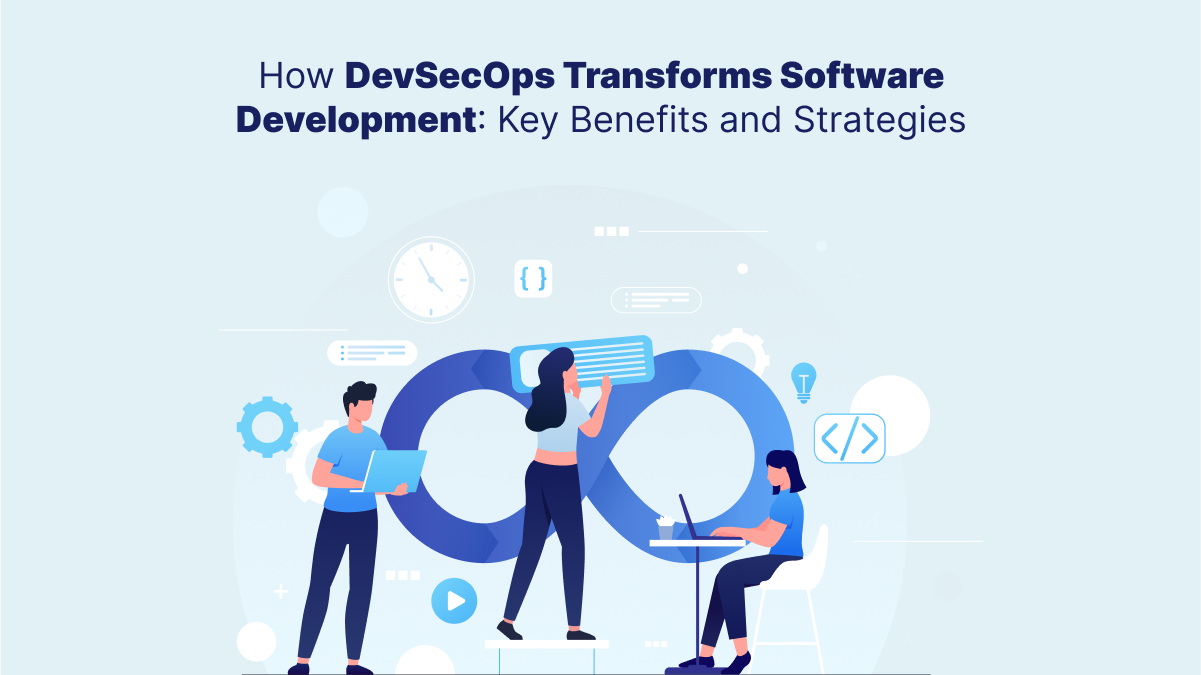
Software development has evolved tremendously over the years. Speed, efficiency, and security have become the top priorities for businesses delivering digital solutions. In this fast-moving landscape, traditional development methods often fail to keep up with growing security threats and rapid delivery demands. This is where DevSecOps comes into play.
DevSecOps, an evolution of DevOps, integrates security practices into the software development lifecycle. It ensures that security is not an afterthought but an essential part of every stage of development. By embedding security into the workflow, organizations can deliver faster, safer, and more reliable software products. Let’s explore how DevSecOps is transforming software development, its key benefits, and the strategies to implement it effectively.
Understanding DevSecOps
What is DevSecOps?
DevSecOps stands for Development, Security, and Operations. It is a cultural and technical shift that integrates security practices directly into the DevOps process. Rather than treating security as a separate concern handled only by specialized teams, DevSecOps embeds security at every step—from planning and coding to testing, deployment, and monitoring.
The goal of DevSecOps is to create a security-first mindset within development teams. By doing so, it minimizes vulnerabilities, enhances compliance, and reduces the risk of cyber threats without slowing down the development process.
The Need for DevSecOps in Modern Development
With applications becoming more complex and cyber threats growing more sophisticated, relying on security checks at the final stages of development is no longer sufficient. Security must evolve alongside the code. DevSecOps enables continuous security assessments, ensuring that potential issues are caught and resolved early, saving time and reducing costs associated with post-deployment fixes.
Key Benefits of DevSecOps
Faster Delivery Without Compromising Security
In traditional development models, adding security checks often delayed product releases. DevSecOps eliminates this bottleneck by integrating automated security tools within the CI/CD pipeline. This approach allows teams to detect and address security flaws in real time, enabling continuous delivery without compromising the safety of the software.
Early Detection of Vulnerabilities
By incorporating security measures from the beginning of the development process, DevSecOps enables early detection of vulnerabilities. Addressing these issues early reduces the risk of significant security breaches, which can be costly and damaging to an organization’s reputation.
Improved Collaboration Across Teams
DevSecOps fosters a collaborative culture where developers, operations teams, and security professionals work together seamlessly. This collaboration ensures that security is a shared responsibility, leading to better communication and faster problem-solving.
Enhanced Compliance
Many industries are subject to strict regulatory requirements regarding data privacy and security. DevSecOps helps organizations maintain compliance by continuously monitoring and enforcing security policies. Automated compliance checks ensure that applications meet industry standards throughout the development lifecycle.
Cost Efficiency
Fixing security issues during the development stage is far less expensive than addressing them after deployment. DevSecOps minimizes the likelihood of costly data breaches and reduces the need for extensive post-release patches, leading to significant cost savings.
Continuous Improvement
DevSecOps promotes a culture of continuous improvement. Teams constantly learn from past vulnerabilities and threats, enhancing their security practices over time. This iterative approach ensures that security measures evolve alongside emerging risks.
Strategies for Implementing DevSecOps
Start with a Security-First Culture
Creating a security-first mindset is essential for successful DevSecOps implementation. This involves educating development, operations, and security teams about the importance of integrating security from the start. Regular training sessions and workshops can help teams stay updated on the latest security threats and best practices.
Integrate Automated Security Tools
Automation is key to scaling DevSecOps effectively. Incorporate tools that perform static and dynamic application security testing (SAST and DAST), dependency scanning, and container security checks. These tools enable continuous monitoring and immediate detection of vulnerabilities.
Shift Left Approach
The shift left strategy involves integrating security testing early in the development cycle. By addressing security at the design and coding stages, teams can catch and resolve issues before they become critical. This proactive approach prevents security from being an afterthought.
Foster Collaboration
Encourage collaboration between development, operations, and security teams through regular meetings, shared goals, and open communication channels. Breaking down silos ensures that everyone is aligned on security priorities and works together towards common objectives.
Implement Continuous Monitoring
Continuous monitoring of applications and infrastructure is vital to detect and respond to security threats in real time. Use monitoring tools that provide visibility into system behavior, network traffic, and user activities to identify suspicious patterns and prevent breaches.
Prioritize Threat Modeling
Threat modeling helps teams identify potential risks and vulnerabilities during the planning phase. By understanding the threat landscape early, teams can design security controls tailored to specific risks, enhancing the overall security posture of the application.
Establish Clear Policies and Compliance Standards
Define clear security policies and compliance requirements for the development process. Ensure that these policies are integrated into the workflow through automated checks and regular audits to maintain compliance with industry standards.
Read More: DevOps Cloud Consulting Services for Scalable IT Setup
Real-World Examples of DevSecOps in Action
Many leading tech companies have successfully adopted DevSecOps to enhance their software development processes.
For instance, Netflix uses a DevSecOps approach to secure its massive streaming platform. By integrating automated security testing into its CI/CD pipeline, Netflix ensures that its applications remain secure while delivering frequent updates to millions of users.
Similarly, Amazon employs DevSecOps to safeguard its vast cloud infrastructure. Automated tools and continuous monitoring help Amazon identify and mitigate security risks promptly, ensuring a secure and reliable cloud environment for its customers.
These examples highlight how DevSecOps enables organizations to balance speed, innovation, and security effectively.
Conclusion
DevSecOps is revolutionizing the way organizations approach software development by making security an integral part of the process. The key benefits include faster delivery, early vulnerability detection, enhanced collaboration, improved compliance, and cost efficiency. By adopting a security-first culture, integrating automated tools, and fostering collaboration, businesses can implement DevSecOps successfully.
As the demand for secure and reliable applications grows, companies that embrace DevSecOps will be better positioned to meet these expectations. Integrating security from the start ensures faster deployments, fewer vulnerabilities, and greater user trust. For entrepreneurs and enterprises looking to strengthen their development practices, partnering with an experienced app development company can provide the necessary expertise and tools to implement DevSecOps effectively. An app development company with a solid grasp of security protocols, automation, and continuous integration can help streamline processes while maintaining robust protection standards.
Whether you are building a ride-hailing service, a financial app, or a gojek clone app, embedding security through DevSecOps will ensure that your software is robust, reliable, and secure from the ground up.

FAQs
What is DevSecOps?
DevSecOps is a practice that integrates security into every stage of the software development and operations process, ensuring continuous security alongside development and deployment.
Why is DevSecOps important?
DevSecOps is important because it helps detect and fix security issues early, reduces costs, ensures compliance, and allows for faster and safer software delivery.
How does DevSecOps improve collaboration?
DevSecOps encourages developers, operations, and security teams to work together, breaking down silos and promoting a shared responsibility for security.
What tools are used in DevSecOps?
Common DevSecOps tools include static application security testing (SAST), dynamic application security testing (DAST), dependency scanning tools, and continuous monitoring solutions.
Can small businesses benefit from DevSecOps?
Yes, small businesses can benefit from DevSecOps by improving their security posture, ensuring compliance, and delivering secure applications more efficiently.








